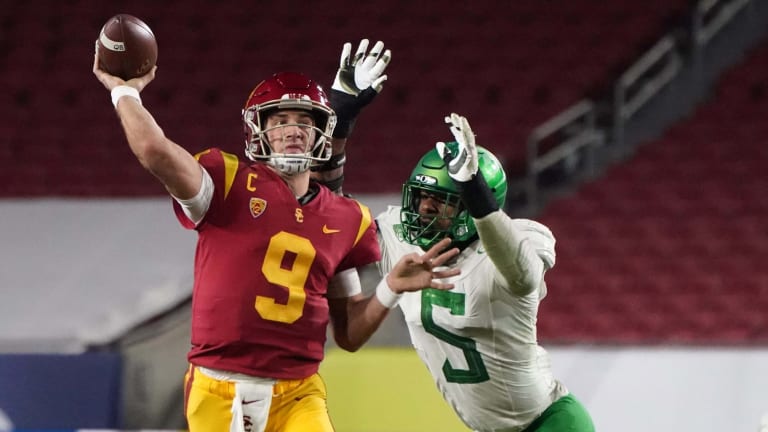
A Jersey Guy: Showtime needs to come to LA in CFB
Project yourself into the future--say November of 2022.
It is a typical rivalry college football weekend across the country.
But in Los Angeles it is different, much different than anyone had seen in decades.
It had been that way since the season started with a growing sense of anticipation which created the following scenario.
Unbeaten UCLA, continuing the magic carpet ride created by the revival of Bruins football the past few seasons under Chip Kelly is ranked No. 3.
The Bruins are the host in the sold out--ticket scalping hub Rose Bowl for unbeaten and No. 4 ranked USC, coached by former Oklahoma coach Bob Stoops.
The scene is magical, Showtime has come to the Rose Bowl and college football in Los Angeles.
Fairy tale time?
Maybe, but it COULD happen if USC does the right thing for USC football, for college football and for the city of Los Angeles by focusing its search on the only person who can almost immediately make USC a national program again.
College football has existed quite well for the past 15 years without an LA presence since both UCLA and USC have been in the early discard pile each season when playoff contenders are discussed.
Oh, there have been some highlight moments at both schools as they searched for the magical formula which made both programs special.
UCLA made the first effort by taking one time flavor of the month Chip Kelly back for a second act in CFB.
Until the start of this season it has been a major flop, with the Bruins a mediocre 10-21 in Kelly's first three seasons in Westwood.
A pair of early wins, including a dramatic win over SEC power LSU a few weeks ago has changed that attitude.
USC has been even more hapless in the sense that no one really seems to know what the Trojans are doing as they change athletic directors, assistant coaches and head coaches on a steady basis.
The firing of Clay Helton following an embarrassing home loss to Stanford had a deja vu feeling similar to the way the Trojans fired Lane Kiffin 8 years ago.
USC and athletic director Mike Bohn have begun a search for a replacement who can make the Trojans relevant again.
The Los Angeles Times and other outlets have a list which includes betwee0 and 13 names.
Now that's narrowing it down.
Really the list should be one.
Bob Stoops.
He has the pedigree-he came to Oklahoma from Steve Spurrier's staff at Florida.
He has the experience, he has the coaching skills, a national championship, had his team ranked in the Top 10 in 11 of his 18 seasons at OU.
Integrity is an issue at USC for a variety of reasons.
Stoops is the leader of that pack.
But he has something else, which USC desperately needs.
He can be larger than life. He will be the face of the program the way Nick Saban is at Alabama and Dabo Swinney is at Clemson and the way John McKay was at USC.
USC needs that more than anything.
The other stuff--recruiting, winning games, competing for titles, are part of it.
But you have to know that USC is in the room when there is gathering of college football powers.
UCLA is trying to do that with Kelly, who quite frankly has flopped his first three seasons, but may have started to figure things out in year 4 of his reign.
Stoops could do that, but nothing suggests he will.
But USC has to try and they need get this transaction right.
Stoops provides the best solution.
It should be his to turn down and USC can't let that happen.
USC needs to close the deal.
***
The mainstream of college football awaits Texas and Oklahoma settling their business with the Big 12 and moving to the SEC, perhaps as soon as next season.
It's strictly a money deal, which means there should be no major road blocks.
Once that happens, the schools from the American Athletic Conference moving to the Big 12--UCF, Houston and Cincinnati--can make their moves.
And once that happens, sources familiar with discussions being held, say that the AAC is ready to expand back to 12 teams, with the primary focus on the Mountain West, where Boise State and San Diego State are the primary targets, with Colorado State and Air Force to a lesser degree.
UAB and Texas-San Antonio are also high interest schools for the AAC, which has a preliminary plan of getting back to 12 schools as quickly as possible before pausing to evaluate the college football landscape.